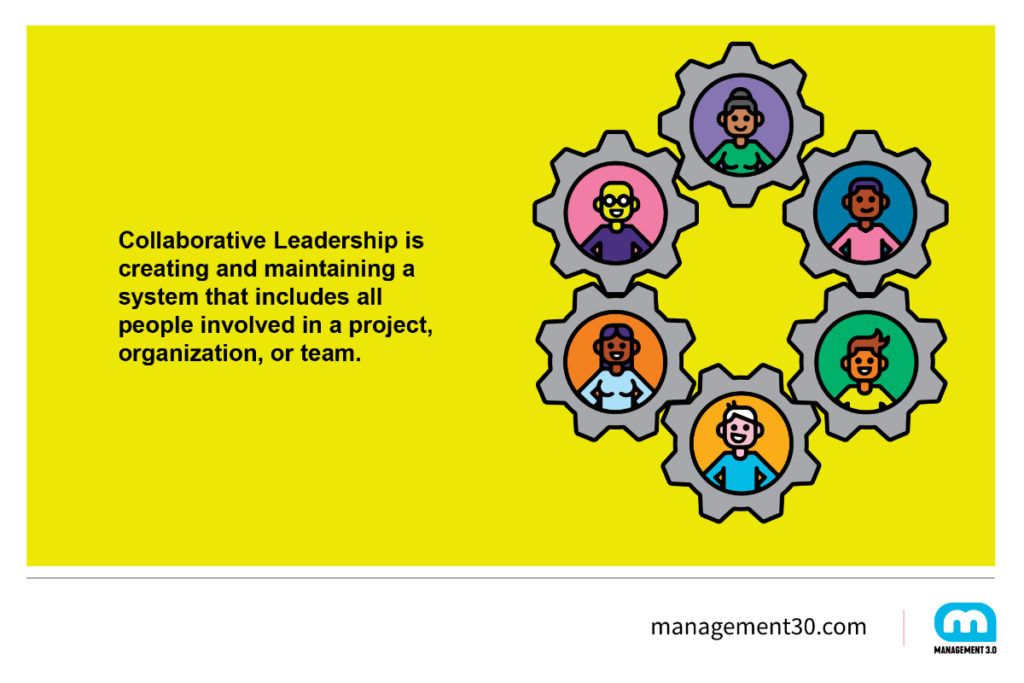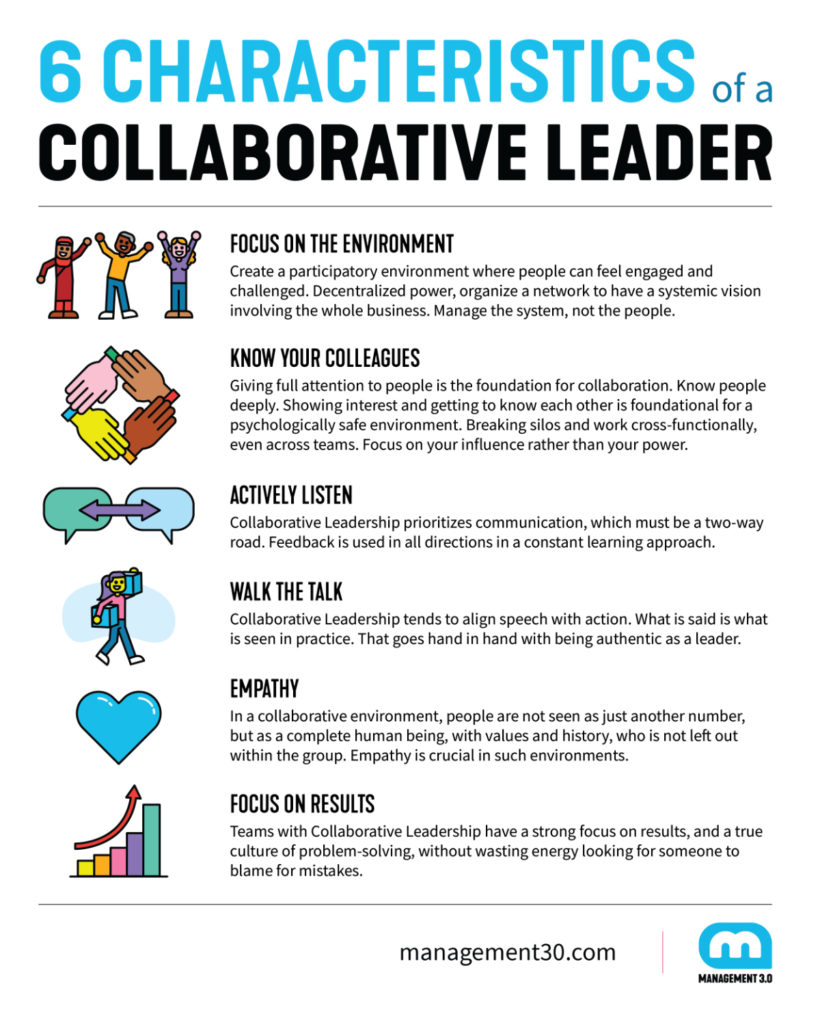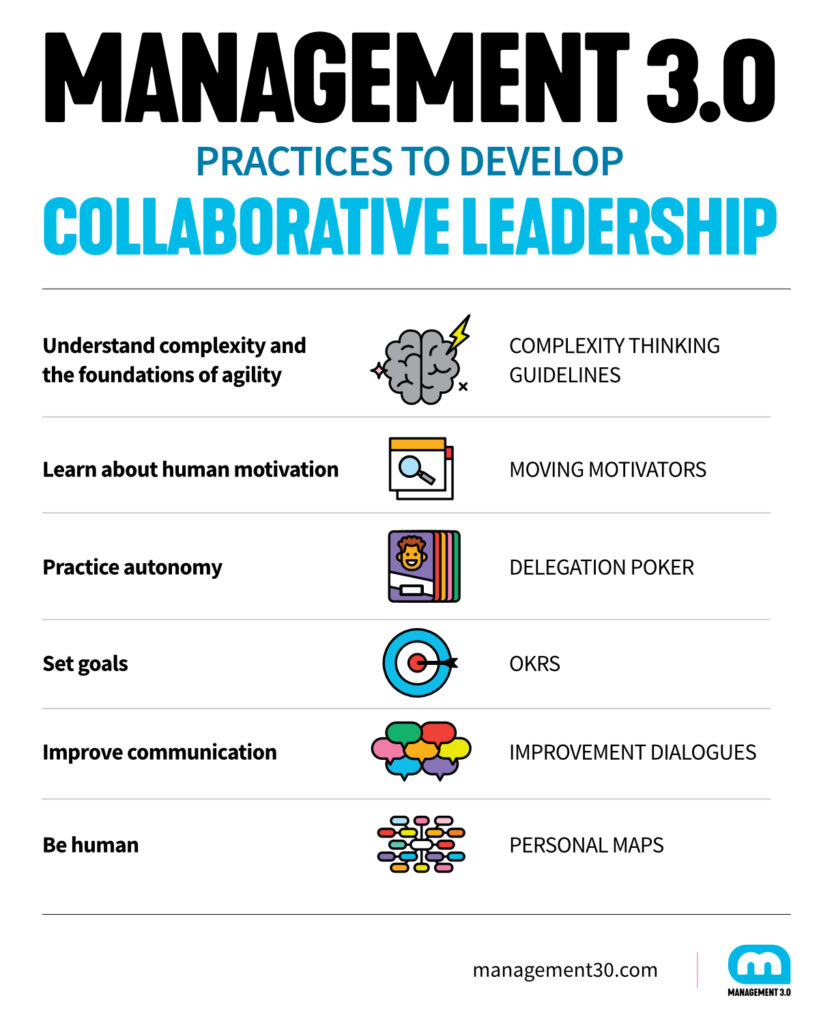Thiago Brant is passionate about leadership and management. He describes himself as a leader based on principles (collaboration, transparency, empathy), who is driven by a strong purpose (He believes in a world where everyone works happily). In this article he explains what Collaborative Leadership means and how you as a leader can leverage that concept.
Quick Links:
- Definition of Collaborative Leadership
- Collaborative Leadership Characteristics
- Importance of Collaborative Leadership
- Test: Are You a Collaborative Leader?
- How to develop Collaborative Leadership
What is a Collaborative Leadership style?
Collaborative team leadership is a management practice that aims to bring managers, executives, and staff out of silos to work together. In collaborative workplaces, information is shared organically, and everyone takes responsibility for the whole. It sits in contrast to traditional top-down organizational models where a small group of executives controls the flow of information.
Alex Samur, for the Slack blog
This definition reminds me of something that I like to experience in the places where I work, which I believe is an indicator of good Collaborative Leadership: meetings where it is not possible to identify the role and hierarchy of the people present since everyone – including the managers – are there to contribute their best to solve the issue at hand.
Simply put, Collaborative Leadership is creating and maintaining a system that includes all people involved in a project, organization, or team.

In this article I try to describe this current concept a little better, aligned with the needs of a post-pandemic world in constant change.
It’s grounded in a belief that all of us together can be smarter, more creative, and more competent than any of us alone, especially when it comes to addressing the kinds of novel, complex, and multi-faceted problems that organizations face today.
I believe Collaborative Leadership makes teams far more creative, adaptable, and capable. These team traits are becoming more and more necessary to deal with today’s complex, modern challenges.
Collaborative Leadership Characteristics
Flat hierarchies, transparency, influence; let’s start by looking into what makes a Collaborative Leader:
(1) The Collaborative Leader focuses primarily on the environment: the leadership challenge is to create a participatory environment where people can feel engaged and challenged. It is an environment with decentralized power, organized in a network where it is possible to have a systemic vision involving the whole business. Manage the system, not the people.
(2) The Collaborative Leader knows his followers (who, in this case, would be his colleagues) very well: full attention to people is the foundation for collaboration. Know people deeply. Showing interest and getting to know each other is foundational for a psychologically safe environment. Collaborative Leadership is about breaking silos and working cross-functional, even across teams. Collaborative Leaders therefore focus on their influence rather than their power.
(3) Active listening: Collaborative Leadership prioritizes communication, which must be a two-way road. Feedback is used in all directions in a constant learning approach.
(4) Walk the talk: Collaborative Leadership tends to align speech with action. What is said is what is seen in practice. That goes hand in hand with being authentic as a leader.
(5) Empathy: In a collaborative environment, people are not seen as just another number, but as a complete human being, with values and history, who is not left out within the group. Empathy is crucial in such environments.
(6) Focus on results: Teams with Collaborative Leadership have a strong focus on results, and a true culture of problem-solving, without wasting energy looking for someone to blame for mistakes.
Why Collaboration Matters: The importance of Collaborative Leadership
Work is changing, and changes are happening faster and faster. The pandemic has led to hybrid work being very common. According to Future Forum, 58% of knowledge workers are working in a hybrid format today.
Leading remote teams and ensuring teamwork, collaboration, and productivity are some of today’s biggest challenges and they are not easy tasks.
And another challenge with the new generation entering the workforce is maintaining alignment and transparency. While 81% of executives consider leadership transparent, only 58% of employees agree with this.
Collaborative Leadership plays a crucial role in this scenario. Managers, executives, and staff need to give up their isolated cells and work collaboratively with everyone else, allowing information to be shared organically while everyone is responsible for the whole (remembering the quote at the beginning of the article).
I see a lot of synergy between this idea and the Management 3.0 maxim: Manage the system, not the people. A Collaborative Leader works the system so that all of this can happen.
Are You a Collaborative Leader?
You may now be wondering: “Am I a Collaborative Leader?”
Here are some questions you can ask yourself if you want to know just how collaborative you are:
| ☐ | Do you acknowledge your mistakes and show vulnerability? |
| ☐ | Do you ask for help when faced with challenges or the unknown? |
| ☐ | Do you do what you say you will do? |
| ☐ | Do you make it easy to identify the causes and practical solutions to a problem, rather than looking for those to blame for the error? |
| ☐ | Do you seek to understand the needs of others before entering into actions and decisions? |
| ☐ | Do you collaborate to make information available and transparent? |
| ☐ | Do you give and receive feedback constantly, using this for your growth? |
| ☐ | Do you take an interest and ask about the lives of the people on your team outside of the work environment? |
| ☐ | Do you give clear directions and expectations to your co-workers? |
| ☐ | Do you recognize the achievements of your team? |
Every YES to the above questions is a positive sign towards Collaborative Leadership.
You may find that you already practice a lot of this leadership style, and you may also notice points where you can develop:
How to get started with Collaborative Leadership:
Developing Collaborative Leadership with Management 3.0 tools and practices
Developing as a leader, and even more so as a Collaborative Leader, requires constant learning and experimentation. The Management 3.0 model is helpful in this journey. I started working on this change in my leadership style when I took the Foundation Workshop in 2018, and I have been working on self-improving over the last few years, adding new knowledge and experiences.
The good news is that because Management 3.0 is an extremely practical management approach, you can start practicing it yourself, learning about the Agile Leadership practices from the website.
I will tell you what has been useful for me in this journey, and I hope it helps you too!
• Develop Collaborative Leadership by understanding complexity and the foundations of agility
It is clear that being agile is not just about frameworks and techniques, but a different way of thinking, which recognizes the complex world in which we operate. Understanding complex thinking and its approaches is especially useful to navigate in agility and to understand the role of a Collaborative Leader.
Try to study and practice the eight Management 3.0 guidelines to deal with complexity:
- Address complexity with complexity
- Use a diversity of perspectives
- Assume subjectivity and coevolution
- Steal and tweak
- Expect dependence on context
- Anticipate, explore, adapt
- Shorten the feedback cycle
- Keep your options open
• Develop Collaborative Leadership by learning about human motivation
A particularly effective way to connect with people and get to know them more deeply, as well as to practice empathy, is to know what is behind human motivation.
The good news is that there are many available studies and tools for this. Management 3.0’s CHAMPFROGS and Moving Motivators help us to work on the top 10 human motivators in the professional sphere:
- Curiosity
- Acceptance
- Power
- Relatedness
- Goal
- Honor
- Mastery
- Freedom
- Order
- Status
• Develop Collaborative Leadership by practicing autonomy
One of the greatest challenges of the Collaborative Leader is to delegate and empower people. The exercise of trust is quite challenging since you first need to trust, and then you can see the benefits of trusting and relying on everyone.
The Scaled Agile Framework (SAFe) has in its principles the number 9: “Decentralize decision-making” which deals with this issue, and proposes a framework to decentralize decisions based on three criteria that would define the suggestion to centralize something:
- Infrequent
- Long-lasting
- Provide significant economies of scale
By doing this exercise you will realize that most of our day-to-day decisions could be delegated.
Management 3.0 addresses this very issue behind its 7 levels of delegation and Delegation Poker, which is a practice that facilitates conversations about autonomy, which are often exceedingly difficult!
• Develop Collaborative Leadership by using OKRs
Objectives and Key Results (OKRs) are on the rise, and there is a perception that it is just a fad, and many companies end up failing to adopt them, or not getting the expected results.
I particularly love the use of OKRs to create a collaborative environment. The effective use of OKRs starts from defining the purpose of an organization to the empowering of the whole team to create good metrics that will be your key results.
It is not easy, but it is rewarding. I suggest getting to know the Management 3.0 approach for OKRs and the 12 Rules for Metric, as well as watching John Doerr’s wonderful TED Talk on the subject, it is truly inspirational!
• Develop Collaborative Leadership by improving communication
Having effective communication is key to Collaborative Leadership, and to all collaboration itself.
Listening and paying attention, nonviolent communication, and powerful questions are particularly important themes for every leader and any professional who wants to prosper.
This theme led me to delve into a little-known but immensely powerful Management 3.0 practice that has brought me great moments as a Collaborative Leader: Improvement Dialogues Cards.
It offers a set of 160 cards with suggestions for starting a conversation that covers 4 distinct types of topics:
- Personal
- Relational
- Organizational
- Environmental
It is also a simple practice, and one that will help you exercise, all at once:
- Active listening
- Powerful questions
- Interest in the other
- Getting to know the other
- Empowerment
- Aligning purpose and action
- Contribute to improvement
I learned a lot about it, and several other good practices, through a fellow Management 3.0 facilitator, Ralph van Roosmalen’s book, Doing It, which I recommend to everyone who wants to become a Collaborative Leader.
• Develop Collaborative Leadership by being human
Finally, I have to mention one of my favorite practices, Personal Maps. A simple and powerful tool that helps us see our colleagues as people who go far beyond the badge, as whole beings. There are numerous ways to use Personal Maps, and hardly anything can go wrong. So the tip is: give it a try! Oh, and let me know how it goes for you. I love Personal Maps, and I love to hear stories of how people use it.
This complex world demands different approaches and solutions than we have ever done before. Collaborative, engaging environments where people feel a sense of belonging are essential to unleashing the creativity needed to thrive in the modern world.
Environments that can develop transparency and autonomy, purpose and motivation, collaboration, and healthy competition, and of course generate results will be the ones that will “defer failure for as long as possible” as we always say in the sixth management vision of Improve Everything.
Collaborative Leadership is crucial to making all this happen! I believe in a world where everyone is happy at work, and I believe that being a Collaborative Leader will get us there!
Read on for making better leadership the norm, not the exception
Photo by mentatdgt (via Pexels)



